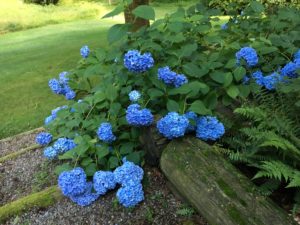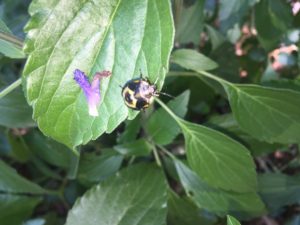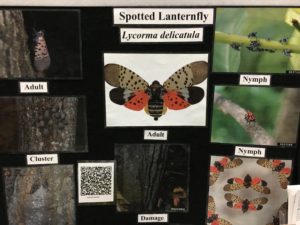Hello fellow readers,
Thanks to those who braved the heat magnification of the glass conservatory during our pow-wow of garden dilemmas at the NJ State Fair. As always, critters were a hot topic. Lorraine of Sparta NJ, a Flower Show volunteer, master gardener, and friend who invited me to talk, came prepared with a photo of a large tick-like looking fella none of us could identify. He’s been sucking the stems of her hyacinth bean vine and honeysuckle vine causing them to wilt then die. My colleague suggested her go-to organic insecticide Captain Jack’s Dead-bug Brew which contains Spinosad (spin-OH-sid). The naturally occurring soil bacterium that’s lethal to many insects was first collected from an abandoned rum distillery in the Caribbean. Fermented bacterium must work like a charm as it’s the ‘duct tape’ in Marty’s garden like neem oil is in mine. According to my buddy Dennis of Blairstown who knows much about bugs, Lorraine’s garden dilemma is likely the nymph of Twice-stabbed Stink Bug (Cosmopepla lintneriana), or a Green Stink Bug (Cinavia hilaris). Turns out the familiar Brown Marmorated Stink Bug (Halyomorpha halys) swarming houses aren’t the only ones that stink.

Voluptuous Hydrangea Year-two after a certain someone in my household pruned them to the ground.
Another audience member shared that her hydrangeas haven’t bloomed in years. Likely they bloom on old wood, unlike the newer varieties such as Endless Summer. We spoke about the last few winters playing tricks on plants – warm falls then a deep freeze causing dieback on plants not yet dormant which could be the cause of her flower-lessness. Of course, deer could be nibbling too. I came home to a lacecap (Hydrangea macrophylla normalis) munched to sticks.
As our chat unfolded, two gentlemen came by. “What are you selling?” one asked. “We’re sharing garden dilemmas. Do you have any?” “I sure do,” they took a seat. “Year after year my tomato plants grow fine then turn black and die.” Blight, the likely culprit, is caused by fungi that can overwinter in the soil. Its prevalent in humid wet seasons such as we’ve had. “Do you rotate crops?” Yes. “Do you buy varieties with the most initials after the name indicating they’ll be the most disease resistant?” Yes. “Maybe it time to give up like I did after the chipmunks won the war taking one bite out of each tomato just as they ripen.” Why do we garden anyway? Kidding aside I hope they won’t give up. Rather, remove and destroy infected plants and install raised beds to improve drainage, then plant tomatoes two feet apart, and stake them to allow good air circulation.
We had some laughs over slug remedies citing a long-ago column about the drunken suckers in a dish of beer. It’s the first I’ve heard of Carol Ann of Branchville’s technique she calls “garden hardware” using two-inch copper tubing around her kale plants. The magnetic charge deters slugs.
Speaking of critters. Rutgers University Extension Office had a display to alert folks about the Spotted Lanternfly (Lycorma delicatula) destroying crops in PA and are now on the move to NJ as we chatted about in February. Just last week the NJ Department of Agriculture issued a quarantine order for Warren and Mercer Counties where sightings have been confirmed as well as Hunterdon County which lies between the two. Businesses and the public are required to fill out a NJ Residence Checklist before moving any articles listed such as recreational gear, outdoor items, building materials, and yard & garden items including plants. Talk about garden dilemmas…. Garden dilemmas? AskMaryStone@gmail.com
If you spot evidence of Spotted Lanternfly: Report findings to the Pennsylvania Department of Agriculture by emailing badbug@pa.gov or call 866-253-7189. The NJ Department of Agriculture, Division of Plant Industry number is (609) 406-6939.
Related previous columns you may enjoy:
Avoid Tomato Carnage; Ripen Indoors




